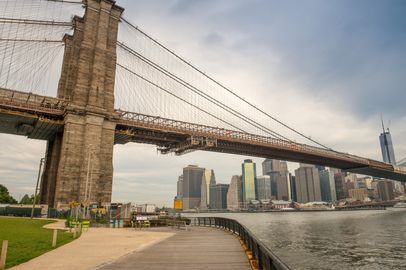

No visit to New York would be complete without sitting down on a bench in front of the East River and gazing out onto the mighty, dignified and elegant Brooklyn Bridge.
Built at the end of 19th century, the Brooklyn Bridge is a combination of a cable-stayed and a suspension bridge. Cable-stayed refers to a bridge in which the weight of the deck is supported by a number of cables running directly to one or more towers. A suspension bridge is one in which the deck is supported by vertical cables suspended from larger cables that run between towers and are anchored in abutments at each end. Although it is not the oldest bridge in New York City - that honor belongs to High Bridge connecting Bronx with Manhattan -the Brooklyn Bridge is one of the oldest bridges of its type in America. The almost 2 kilometer structure connects the Boroughs of Manhattan and Brooklyn and on an average day as many as 130,000 cars, 3,000 cyclists and 4,000 pedestrians can cross it.
Back in the 19th century the bridge was called the New York and Brooklyn Bridge, or just the East River Bridge, but in the beginning of the 20th century the local Brooklyn Daily Eagle newspaper actively promoted the name of its borough and since 1915 the bridge has officially been called the Brooklyn Bridge.
The initial stages of the bridge's construction were difficult, especially for its architects. It was originally designed in neo-Gothic style by a German immigrant named John Augustus Roebling. The towers were to be built out of limestone, granite and Rosendale cement, a type of cement found in upstate New York. While preparing for the construction Roebling had an accident that injured his foot and left him with a tetanus infection, from which he soon died. He was immediately replaced by his son Washington, who, soon after beginning construction, was paralyzed as a result of decompression sickness. He had obtained the sickness after working in the caissons, the watertight structures that are used for building the foundation of bridges underwater. However, Washington did not die and continued supervising construction from his apartment overlooking the bridge and with the help of his wife Emily, who was the first to cross the bridge when it opened. The cost of the project was 27 human lives and $15.5 million, which would roughly be half a billion dollars today.
Today the Brooklyn Bridge is one of the most popular New York locations not only for tourists, but for New Yorkers as well. It contains wide pedestrian and cycling paths and its weblike cables and medieval-styled towers and arches have inspired a countless number of photographers and painters. The best time of day to marvel at this architectural feat from the Manhattan side is obviously at daybreak when the sun is beginning its ascent over the Borough of Brooklyn, and then the rest of New York City.